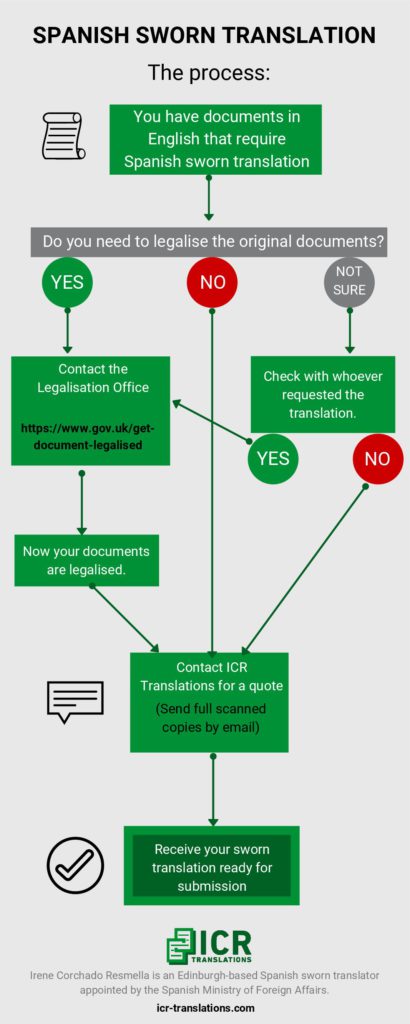Last updated on 12/05/24
The Spanish sworn translation process might be a bit confusing for those who have never required those services before. What does it involve? Can any translator do it? What is legalisation? Can translators legalise documents?
To help you understand what you need to do when asked to submit your official documents in Spanish, here’s an explanation of the Spanish sworn translation process with ICR Translations.
Contents
The process: an overview
The process has two steps and it requires:
- Getting the original document legalised
- Have the legalised document translated by a Spanish sworn translator
Legalisation (Apostille)
Legalisation is the process by which the UK government confirms the signature, stamp or seal on your document is genuine. This is required for your document to be valid abroad and it usually consists of attaching an Apostille Certificate to the document.
The Legalisation Office is the institution dealing with legalisations. Getting your document legalised is a fairly easy and affordable process. Go to the Legalisation Office’s website and simply follow the steps. Please allow a week (excluding courier or postage time) to get your documents legalised.
If you find the process difficult or you need your documents legalised as a matter of urgency, contact a Notary Public or a firm of solicitors. As the Legalisation Office offers a premium service to registered businesses, they may be able to arrange a speedy legalisation for you.
Important: some documents need to be signed, certified and dated in the UK by a practising solicitor or a Notary Public before being sent for the Apostille. Check the legalisation requirements for each document on the Legalistion Office’s website.
The Spanish sworn translation process with ICR
Once you receive your documents back from legalisation and are ready for a quote, email scanned copies of your documents. If you use a mobile scanning app, take one picture per page only on a flat, neutral surface and make sure you read the terms of use and agree to their privacy policy before using the app.
I will then prepare and send a formal quotation, including the confirmation process and my terms of service.
The image below sums up the process pretty well:

Spanish sworn translation FAQs:
Can you quote without seeing the document?
ICR can only quote after seeing your documents. Please send a scanned copy to receive a quotation. Read more about my ‘no document, no quotation’ policy.
Can collect documents in person?
ICR Translations has a digital-first approach and, as a general rule, does not accept collections in person. Hard copies are posted using Royal Mail Special Delivery (Next Day Guaranteed) and digital sworn translations are delivered by email.
Can you certify an already translated document?
No. A sworn translator takes full responsibility for the certified translation and ICR Translations does not certify translations made by third parties.
DISCLAIMER
The information included in this article is correct at the time of publication/last update. This article is for informational purposes only, does not constitute legal advice and should not be relied upon as such. Any reliance you place on such information is strictly at your own risk. ICR Translations will not be liable for any loss or damage arising from loss of data or profits as a result of, or in connection with, the use of this website.

Irene Corchado Resmella, a Spanish translator based in Edinburgh. English-Spanish sworn translator appointed by the Spanish Ministry of Foreign Affairs, Chartered Linguist and member of the CIOL. As a legal translator, I focus on Private Client law, specialising in Wills and Succession across three jurisdictions (England & Wales, Spain, and Scotland). Affiliate member of STEP. ICR Translations is registered with the ICO and has professional indemnity insurance.





